Various Works Read online
Page 74
a reasonable view also that the embryo being larger takes more
nourishment, so that less is left over about this time, and the less
is concocted more quickly.
That milk has the same nature as the secretion from which each
animal is formed is plain, and has been stated previously. For the
material which nourishes is the same as that from which Nature forms
the animal in generation. Now this is the sanguineous liquid in the
sanguinea, and milk is blood concocted (not corrupted; Empedocles
either mistook the fact or made a bad metaphor when he composed the
line: 'On the tenth day of the eighth month the milk comes into being,
a white pus', for putrefaction and concoction are opposite things, and
pus is a kind of putrefaction but milk is concocted). While women are
suckling children the catamenia do not occur according to Nature,
nor do they conceive; if they do conceive, the milk dries up. This
is because the nature of the milk and of the catamenia is the same,
and Nature cannot be so productive as to supply both at once; if the
secretion is diverted in the one direction it must needs cease in
the other, unless some violence is done contrary to the general
rule. But this is as much as to say that it is contrary to Nature, for
in all cases where it is not impossible for things to be otherwise
than they generally are but where they may so happen, still what is
the general rule is what is 'according to Nature'.
The time also at which the young animal is born has been well
arranged. For when the nourishment coming through the umbilical cord
is no longer sufficient for the foetus because of its size, then at
the same time the milk becomes useful for the nourishment of the
newly-born animal, and the blood-vessels round which the so-called
umbilical cord lies as a coat collapse as the nourishment is no longer
passing through it; for these reasons it is at that time also that the
young animal enters into the world.
9
The natural birth of all animals is head-foremost, because the parts
above the umbilical cord are larger than those below. The body then,
being suspended from the cord as in a balance, inclines towards the
heavy end, and the larger parts are the heavier.
10
The period of gestation is, as a matter of fact, determined
generally in each animal in proportion to the length of its life. This
we should expect, for it is reasonable that the development of the
long-lived animals should take a longer time. Yet this is not the
cause of it, but the periods only correspond accidentally for the most
part; for though the larger and more perfect sanguinea do live a
long time, yet the larger are not all longer-lived. Man lives a longer
time than any animal of which we have any credible experience except
the elephant, and yet the human kind is smaller than that of the
bushy-tailed animals and many others. The real cause of long life in
any animal is its being tempered in a manner resembling the environing
air, along with certain other circumstances of its nature, of which we
will speak later; but the cause of the time of gestation is the size
of the offspring. For it is not easy for large masses to arrive at
their perfection in a small time, whether they be animals or, one
may say, anything else whatever. That is why horses and animals akin
to them, though living a shorter time than man, yet carry their
young longer; for the time in the former is a year, but in the
latter ten months at the outside. For the same reason also the time is
long in elephants; they carry their young two years on account of
their excessive size.
We find, as we might expect, that in all animals the time of
gestation and development and the length of life aims at being
measured by naturally complete periods. By a natural period I mean,
e.g. a day and night, a month, a year, and the greater times
measured by these, and also the periods of the moon, that is to say,
the full moon and her disappearance and the halves of the times
between these, for it is by these that the moon's orbit fits in with
that of the sun [the month being a period common to both].
The moon is a first principle because of her connexion with the
sun and her participation in his light, being as it were a second
smaller sun, and therefore she contributes to all generation and
development. For heat and cold varying within certain limits make
things to come into being and after this to perish, and it is the
motions of the sun and moon that fix the limit both of the beginning
and of the end of these processes. Just as we see the sea and all
bodies of water settling and changing according to the movement or
rest of the winds, and the air and winds again according to the course
of the sun and moon, so also the things which grow out of these or are
in these must needs follow suit. For it is reasonable that the periods
of the less important should follow those of the more important. For
in a sense a wind, too, has a life and birth and death.
As for the revolutions of the sun and moon, they may perhaps
depend on other principles. It is the aim, then, of Nature to
measure the coming into being and the end of animals by the measure of
these higher periods, but she does not bring this to pass accurately
because matter cannot be easily brought under rule and because there
are many principles which hinder generation and decay from being
according to Nature, and often cause things to fall out contrary to
Nature.
We have now spoken of the nourishment of animals within the mother
and of their birth into the world, both of each kind separately and of
all in common.
Book V
1
WE must now investigate the qualities by which the parts of
animals differ. I mean such qualities of the parts as blueness and
blackness in the eyes, height and depth of pitch in the voice, and
differences in colour whether of the skin or of hair and feathers.
Some such qualities are found to characterize the whole of a kind of
animals sometimes, while in other kinds they occur at random, as is
especially the case in man. Further, in connexion with the changes
in the time of life, all animals are alike in some points, but are
opposed in others as in the case of the voice and the colour of the
hair, for some do not grow grey visibly in old age, while man is
subject to this more than any other animal. And some of these
affections appear immediately after birth, while others become plain
as age advances or in old age.
Now we must no longer suppose that the cause of these and all such
phenomena is the same. For whenever things are not the product of
Nature working upon the animal kingdom as a whole, nor yet
characteristic of each separate kind, then none of these things is
such as it is or is so developed for any final cause. The eye for
instance exists for a final cause, but it is not blue for a final
cause unless this condition be characteristic of the kind of animal.
&nbs
p; In fact in some cases this condition has no connexion with the essence
of the animal's being, but we must refer the causes to the material
and the motive principle or efficient cause, on the view that these
things come into being by Necessity. For, as was said originally in
the outset of our discussion, when we are dealing with definite and
ordered products of Nature, we must not say that each is of a
certain quality because it becomes so, but rather that they become
so and so because they are so and so, for the process of Becoming or
development attends upon Being and is for the sake of Being, not
vice versa.
The ancient Nature-philosophers however took the opposite view.
The reason of this is that they did not see that the causes were
numerous, but only saw the material and efficient and did not
distinguish even these, while they made no inquiry at all into the
formal and final causes.
Everything then exists for a final cause, and all those things which
are included in the definition of each animal, or which either are
means to an end or are ends in themselves, come into being both
through this cause and the rest. But when we come to those things
which come into being without falling under the heads just
mentioned, their course must be sought in the movement or process of
coming into being, on the view that the differences which mark them
arise in the actual formation of the animal. An eye, for instance, the
animal must have of necessity (for the fundamental idea of the animal
is of such a kind), but it will have an eye of a particular kind of
necessity in another sense, not the sense mentioned just above,
because it is its nature to act or be acted on in this or that way.
These distinctions being drawn let us speak of what comes next in
order. As soon then as the offspring of all animals are born,
especially those born imperfect, they are in the habit of sleeping,
because they continue sleeping also within the mother when they
first acquire sensation. But there is a difficulty about the
earliest period of development, whether the state of wakefulness
exists in animals first, or that of sleep. Since they plainly wake
up more as they grow older, it is reasonable to suppose that the
opposite state, that of sleep, exists in the first stages of
development. Moreover the change from not being to being must pass
through the intermediate condition, and sleep seems to be in its
nature such a condition, being as it were a boundary between living
and not living, and the sleeper being neither altogether
non-existent nor yet existent. For life most of all appertains to
wakefulness, on account of sensation. But on the other hand, if it
is necessary that the animal should have sensation and if it is then
first an animal when it has acquired sensation, we ought to consider
the original condition to be not sleep but only something resembling
sleep, such a condition as we find also in plants, for indeed at
this time animals do actually live the life of a plant. But it is
impossible that plants should sleep, for there is no sleep which
cannot be broken, and the condition in plants which is analogous to
sleep cannot be broken.
It is necessary then for the embryo animal to sleep most of the time
because the growth takes place in the upper part of the body, which is
consequently heavier (and we have stated elsewhere that such is the
cause of sleep). But nevertheless they are found to wake even in
the womb (this is clear in dissections and in the ovipara), and then
they immediately fall into a sleep again. This is why after birth also
they spend most of their time in sleep.
When awake infants do not laugh, but while asleep they both laugh
and cry. For animals have sensations even while asleep, not only
what are called dreams but also others besides dreams, as those
persons who arise while sleeping and do many things without
dreaming. For there are some who get up while sleeping and walk
about seeing just like those who are awake; these have perception of
what is happening, and though they are not awake, yet this
perception is not like a dream. So infants presumably have
sense-perception and live in their sleep owing to previous habit,
being as it were without knowledge of the waking state. As time goes
on and their growth is transferred to the lower part of the body, they
now wake up more and spend most of their time in that condition.
Children continue asleep at first more than other animals, for they
are born in a more imperfect condition than other animals that are
produced in anything like a perfect state, and their growth has
taken place more in the upper part of the body.
The eyes of all children are bluish immediately after birth; later
on they change to the colour which is to be theirs permanently. But in
the case of other animals this is not visible. The reason of this is
that the eyes of other animals are more apt to have only one colour
for each kind of animal; e.g. cattle are dark-eyed, the eye of all
sheep is pale, of others again the whole kind is blue or grey-eyed,
and some are yellow (goat-eyed), as the majority of goats
themselves, whereas the eyes of men happen to be of many colours,
for they are blue or grey or dark in some cases and yellow in
others. Hence, as the individuals in other kinds of animals do not
differ from one another in the colour, so neither do they differ
from themselves, for they are not of a nature to have more than one
colour. Of the other animals the horse has the greatest variety of
colour in the eye, for some of them are actually heteroglaucous;
this phenomenon is not to be seen in any of the other animals, but man
is sometimes heteroglaucous.
Why then is it that there is no visible change in the other
animals if we compare their condition when newly born with their
condition at a more advanced age, but that there is such a change in
children? We must consider just this to be a sufficient cause, that
the part concerned has only one colour in the former but several
colours in the latter. And the reason why the eyes of infants are
bluish and have no other colour is that the parts are weaker in the
newly born and blueness is a sort of weakness.
We must also gain a general notion about the difference in eyes, for
what reason some are blue, some grey, some yellow, and some dark. To
suppose that the blue are fiery, as Empedocles says, while the dark
have more water than fire in them, and that this is why the former,
the blue, have not keen sight by day, viz. owing to deficiency of
water in their composition, and the latter are in like condition by
night, viz. owing to deficiency of fire- this is not well said if
indeed we are to assume sight to be connected with water, not fire, in
all cases. Moreover it is possible to render another account of the
cause of the colours, but if indeed the fact is as was stated before
in the treatise on the senses, and still earlier than that in the
investigations c
oncerning soul- if this sense organ is composed of
water and if we were right in saying for what reason it is composed of
water and not of air or fire- then we must assume the water to be
the cause of the colours mentioned. For some eyes have too much liquid
to be adapted to the movement, others have too little, others the
due amount. Those eyes therefore in which there is much liquid are
dark because much liquid is not transparent, those which have little
are blue; (so we find in the sea that the transparent part of it
appears light blue, the less transparent watery, and the
unfathomable water is dark or deep-blue on account of its depth).
When we come to the eyes between these, they differ only in degree.
We must suppose the same cause also to be responsible for the fact
that blue eyes are not keen-sighted by day nor dark eyes by night.
Blue eyes, because there is little liquid in them, are too much
moved by the light and by visible objects in respect of their
liquidity as well as their transparency, but sight is the movement
of this part in so far as it is transparent, not in so far as it is
liquid. Dark eyes are less moved because of the quantity of liquid
in them. And so they see less well in the dusk, for the nocturnal
light is weak; at the same time also liquid is in general hard to move
in the night. But if the eye is to see, it must neither not be moved
at all nor yet more than in so far as it is transparent, for the
stronger movement drives out the weaker. Hence it is that on
changing from strong colours, or on going out of the sun into the
dark, men cannot see, for the motion already existing in the eye,
being strong, stops that from outside, and in general neither a strong
nor a weak sight can see bright things because the liquid is acted
upon and moved too much.
The same thing is shown also by the morbid affections of each kind
of sight. Cataract attacks the blue-eyed more, but what is called
'nyctalopia' the dark-eyed. Now cataract is a sort of dryness of the
eyes and therefore it is found more in the aged, for this part also

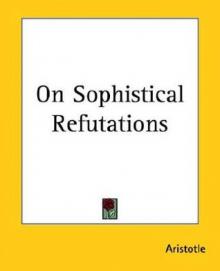 On Sophistical Refutations
On Sophistical Refutations The Categories
The Categories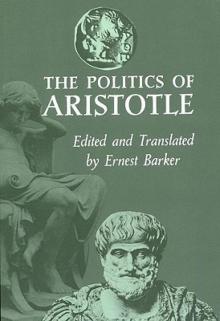 The Politics of Aristotle
The Politics of Aristotle Nicomachean Ethics
Nicomachean Ethics The Rhetoric & the Poetics of Aristotle
The Rhetoric & the Poetics of Aristotle POSTERIOR ANALYTICS
POSTERIOR ANALYTICS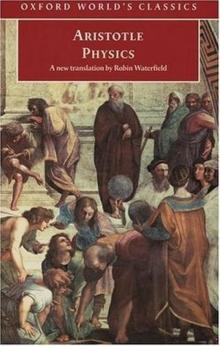 Physics
Physics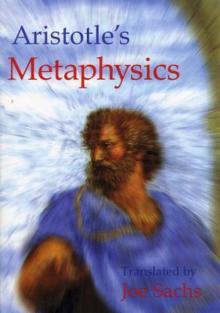 Metaphysics
Metaphysics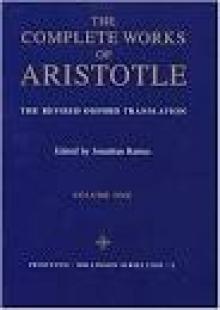 Various Works
Various Works